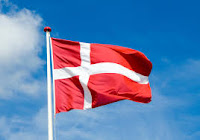It was the longest day of the year, a day called The Summer Solstice. We had just left the Minneapolis area whose residents were expected to celebrate the day with songs, dances and delicacies while circling the annual Maypole. A day to celebrate the sun after a long cold winter. But at this time, we were on the highway
 having left the celebrations , finding ourselves in a mass of cars heading south, most likely trying to get back to work and earn more money in order to be able to return to the north next weekend! Sun worshipers of a different nature. It truly was the longest day of the year!
having left the celebrations , finding ourselves in a mass of cars heading south, most likely trying to get back to work and earn more money in order to be able to return to the north next weekend! Sun worshipers of a different nature. It truly was the longest day of the year!
- - - - -
 There has been many examples of catastrophic episodes in history and it is easy to imagine 'Early Man' observing eclipses , meteorites, comets and other phenomena and connecting it with the sun disappearing in dark clouds and wild weather. All controlled by an apparent invisible god-the Sungod.
There has been many examples of catastrophic episodes in history and it is easy to imagine 'Early Man' observing eclipses , meteorites, comets and other phenomena and connecting it with the sun disappearing in dark clouds and wild weather. All controlled by an apparent invisible god-the Sungod.
- - - - -
The sun has been given an extraordinary position in early human culture , possibly as social leaders used their knowledge of seasons to maintain their own power and status through the ignorance of the masses. After a long winter of little or no sunlight, everyone would welcome and celebrate the anticipated season of growth and renewal. The word 'solstice' comes from the Latin 'sol' ( sun) and 'steare' ( to stand and stop) while it's celebration dates back to ancient pre-Christian tradition. For the Greeks, it would mark the start of the new year. Our Native American tribes celebrate the longest day of the year with a Sun Dance.
- - - - -
Songs and dancing around the maypole are traditional Midsummer fare. This with handcrafts, and flowery wreaths help create a joyous time. Midsummer, also known as St John's Day, is the period of time centered upon the summer solstice on a day between June 19 and June 25 , beginning on the preceding evening. The exact dates vary between different cultures.
- - - - -
Scandinavian celebrations included everyone. Sweden residents celebrated their "Midsummer" with games after dancing around the Maypole..a Maypole in July!?
 Raising and dancing around a maypole (majstång or midsommarstång) is an activity that attracts families and many others. Greenery placed over houses and barns was expected to bring good fortune and health to people and livestock; This old tradition of decorating with greens continues, though most don't take it seriously. att maja' (to may) be the origin of the word. Other researchers say the term came from German merchants who raised the maypole in June because the Swedish climate made it impossible to find the necessary greens and flowers in May, but continued to call it a maypole. Today, however, it is most commonly called a "midsommarstång" (literally midsummer pole).. To decorate with greens was called 'majstång,
Raising and dancing around a maypole (majstång or midsommarstång) is an activity that attracts families and many others. Greenery placed over houses and barns was expected to bring good fortune and health to people and livestock; This old tradition of decorating with greens continues, though most don't take it seriously. att maja' (to may) be the origin of the word. Other researchers say the term came from German merchants who raised the maypole in June because the Swedish climate made it impossible to find the necessary greens and flowers in May, but continued to call it a maypole. Today, however, it is most commonly called a "midsommarstång" (literally midsummer pole).. To decorate with greens was called 'majstång,
- - - - -
The night before would be marked by fires. Early fires must have been used as warning signals to friends making them award of invaders. In this case, the highlands would be the first to welcome the new sun. These fires are known today as bonfires and enjoyed even by today's celebrations in annual events.Scholastic students annually gather anything burnable in a great heap and enjoy the burning spectacle of 'The Bonfire' before the Homecoming Game.
- - - - -
 The "piling" of material to burn is noted in history . In Norway and Denmark, the man event is and was the Jonsok" or the birth of "John, The Baptist". Mock weddings between adults and even children were meant to symbolize the blossoming of new life.When Christianity entered pagan areas, these celebrations came to be transferred into these traditions.At nightfall, the traditional mountain fires would be lit on June 23rd anticipating the coming celebrations.
The "piling" of material to burn is noted in history . In Norway and Denmark, the man event is and was the Jonsok" or the birth of "John, The Baptist". Mock weddings between adults and even children were meant to symbolize the blossoming of new life.When Christianity entered pagan areas, these celebrations came to be transferred into these traditions.At nightfall, the traditional mountain fires would be lit on June 23rd anticipating the coming celebrations.
- - - - -
The celebration of Midsummer's Eve came from ancient times in festivals of the summer solstice. Bonfires were lit to protect against evil spirits which were believed to roam freely when the sun was turning southward again. A 13th century English monk recorded that St. John's Eve ceremonies were to include cleaning the area of winter rubbish and bones and then burn them. The smoke from these bonefires were expected to drive away all evil spirits of the cold winter season. As time went on, the 'e' disappeared, but the bonfire remained to this day.
- - - - -
June is marked on our calendar as the beginning of summer and, more importantly, vacation-time and outdoor activities that often include traveling long distances. Even Finnish people are known to mass-exist their cities for countryside cabins for days. Americans crowd the beaches, lakes, nightly bonfires; then hurry home on Sundays to prepare for the next weekend's return trip to the country to enjoy the sunshine.
There is an old saying "Very little changes, under the sun".

















